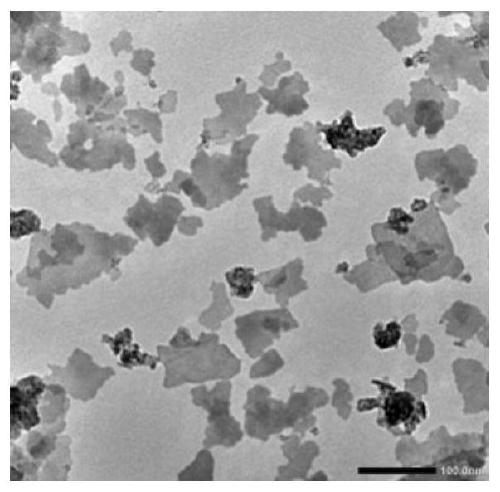Sensitizer for radiotherapy and preparation method and application of sensitizer
A sensitizer and tumor radiotherapy technology, which is applied in the fields of nanomaterial chemistry and biochemistry, can solve the problems of radiosensitizers failing to improve the hypoxic state of tumor microenvironment, large amount of radioactive agent, and large tissue damage. and promotion, reducing dosage and reducing damage
- Summary
- Abstract
- Description
- Claims
- Application Information
AI Technical Summary
Problems solved by technology
Method used
Image
Examples
Embodiment 1
[0046] A specific embodiment of the present invention discloses a sensitizer for radiotherapy, the molecular formula of the sensitizer is BiO 2-x , there are oxygen defects in the molecular structure, and the raw materials for the preparation of the sensitizer include alkali metal hydroxides and bismuth salts.
[0047] Compared with the prior art, on the one hand, the molecular structure of the sensitizer provided in this example has oxygen defects, and the bismuth oxide containing oxygen defects can efficiently catalyze hydrogen peroxide to generate oxygen, and has an effect similar to that of catalase. Oxygen produced by catalysis can improve tumor hypoxia and increase tumor radiosensitivity, thereby reducing the amount of radiotherapeutic agents, thereby reducing damage to normal tissues, and achieving a very good inhibitory effect on tumors at lower radiation doses. On the other hand, by selecting metal bismuth with a specific atomic number, it has very good absorption pro...
Embodiment 2
[0053] Another embodiment of the present invention discloses a method for preparing a sensitizer, which is used to prepare the sensitizer for radiotherapy in Example 1, comprising the following steps:
[0054] Step 1: Disperse 0.8-1.2 g of alkali metal hydroxide and 1 g of bismuth salt in deionized water, and stir to obtain a solution;
[0055] Step 2: Transfer the solution to a reaction vessel, heat to 160-200°C, and react for 4-10 hours;
[0056] Step 3: Cool to room temperature, wash with deionized water, and dry at 60-100°C for 2-8 hours to obtain BiO 2-x .
[0057] It should be noted that in step 2, the reaction time cannot be too long, because if the time is too long, many by-products will be generated, such as other oxidation products of bismuth, which will affect the sensitivity to tumor radiotherapy; incomplete. Controlling the reaction time to 4-10 hours and controlling the reaction temperature to 160-200°C can ensure that the bismuth oxide obtained from the react...
Embodiment 3
[0065] (1) Take 0.5g NaOH and 1g NaBiO 3 Disperse in 15mL deionized water, stir for 2 hours to disperse evenly;
[0066] (2) Transfer the uniformly stirred solution to a 50 mL hydrothermal kettle, and react at 160° C. for 10 hours. After cooling to room temperature, wash 5 times with deionized water, and bake at 60°C for 8 hours;
[0067] (3) 400mg BiO 2-x Dissolve in 16mL water and 16mL ethanol, then add 16μL Tween-20 (Tween-20) to obtain a mixed solution;
[0068] (4) Ultrasonic (300W) the mixed solution in the ultrasonic pool for 30 minutes;
[0069] (5) Use an ultrasonic cell disruptor to crush for 12 hours, take it out after the crushing is completed, cover it with a sealing film and let it stand overnight, remove the material precipitated at the bottom, and take the evenly dispersed solution in the upper layer;
[0070] (6) Centrifuge at 12000rpm for 5 minutes, continue to wash with deionized water three times, and then freeze-dry it for later use.
[0071] The synt...
PUM
| Property | Measurement | Unit |
|---|---|---|
| Thickness | aaaaa | aaaaa |
Abstract
Description
Claims
Application Information
 Login to View More
Login to View More - R&D
- Intellectual Property
- Life Sciences
- Materials
- Tech Scout
- Unparalleled Data Quality
- Higher Quality Content
- 60% Fewer Hallucinations
Browse by: Latest US Patents, China's latest patents, Technical Efficacy Thesaurus, Application Domain, Technology Topic, Popular Technical Reports.
© 2025 PatSnap. All rights reserved.Legal|Privacy policy|Modern Slavery Act Transparency Statement|Sitemap|About US| Contact US: help@patsnap.com



